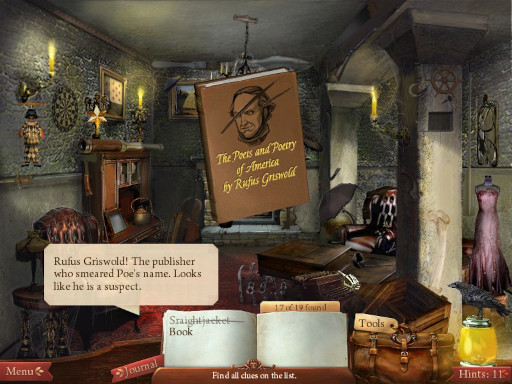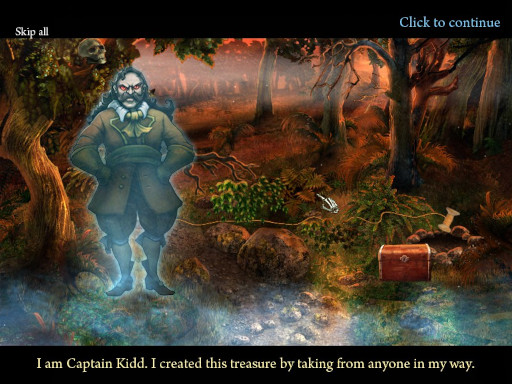|
Midnight Mysteries: The Edgar Allan Poe Conspiracy
Year Published: 2009
Publisher: MumboJumbo
Developer: MumboJumbo
|
The first entry in MumboJumbo's Midnight Mysteries series was a huge step forward for the hidden object game genre. It proved that a genuine story could be woven around scenes where you hunt and peck for items from a list and puzzles could be utilized to reveal clues and advance the plot. It was the start of a series that set a new bar for HOG's that has, in some ways, never been surpassed.
An author with writer's block is visited one night by a mysterious raven that flies in through an open window. The author is given no gender or race and never seen in any capacity - in the most literal sense the author is the player. The raven would seem to be the one from Edgar Allan Poe's famous poem as it heralds the arrival of his ghost on the author's balcony. Poe's ghost beseeches the author to solve the mystery of his death by midnight, or else the weight of the chains he is wearing will drag him down to the underworld forever. The author begins by looking for clues around Poe's grave at Westminster Hall.

Searching for clues at Poe's grave
If you had only played hidden object games made before Midnight Mysteries (or even some terrible ones that came later), you will notice many advancements right away. Older HOG's often used static backdrops (usually CG renders) that, while sometimes pretty, never really made you feel like you were directly involved in the scene. The backgrounds in Midnight Mysteries are gorgeously crafted, a combination of CG and hand-drawn art, and feature subtle animations that breathe life into the environments. Tree branches and leaves blowing in the wind, water flowing, and lighting effects changing for the sun at different times of the day are just a few examples.
But what good are pretty pictures without any sound? Ambient effects (wind, surf, seagulls) and a subdued, mostly piano-based, yet highly-effective soundtrack by composer Vasily Shestovets round out the extra touches that give you a sense of really being there - in a haunted cemetery in the middle of the night, in Paris on the Seine in autumn, or exploring a creepy forest on Sullivan Island at sundown. Clearly, MumboJumbo did not envision this game as shovelware. This is an experience you would remember. It would leave you wanting more.
As you pursue the quest in the Baltimore cemetery, you will eventually find Poe's watch, which has the power of time travel, and this is where things get really interesting. Anyone who is familiar with the mysterious circumstances of Poe's death in the real world knows that solving it in modern times has proven insurmountable, and though many causes are highly disputed, none are entirely conclusive. Poe's ghost in Midnight Mysteries believes that he was actually murdered and the only way to solve the case is to travel through time and experience certain events for yourself. The areas and times you travel to are based on some of Poe's writings and some of his actual life, near the end of it.

The Black Cat Easter Egg
I would not necessarily say you have to be a Poe buff to enjoy Midnight Mysteries, but the more you do know, the more you will likely get out of it. A huge portion of the story is dedicated to "The Mystery of Marie Roget", a story Poe wrote that was based on the real-life unsolved murder of Mary Rogers, a woman who worked at a cigar store in New York that many famous politicians and writers, including Poe himself, patronized. You will, in fact, solve the mystery of Rogers's murder before you can solve Poe's, as the two, according to this game's canon, are intertwined. Other Poe works that are cited include, "The Black Cat", "The Cask of Amontillado", "The Pit and the Pendulum", "The Masque of the Red Death", and "The Gold Bug" (with you taking the role of the character "Jupiter" so we don't have to deal with that pesky racism that's common to a lot of "old" writing). The story even pays homage to the legendary "Poe Toaster".
As you travel through time and space, you will meet many people who actually existed during Poe's life and some from his writings, such as C. Auguste Dupin, often credited as being the first ever fictional detective. Curiously, they vanish like ghosts after speaking with them. While this idea of the characters you meet in the past being ghosts would carry over into the game's sequels, this is the only one in which they are all drawn as stylized cartoon characters instead of wispy outlines. Also curious is that the three ghosts who seek your help - Poe, Mary Rogers, and William Legrand from the "Gold Bug" chapter - are all drawn more realistically, yet look more like actual ghosts. Poe resembles his famous daguerreotypes, but Rogers does not look like any known image of her. Legrand, of course, is entirely fictional.

A clue to a possible suspect
All of this atmosphere and storytelling is impressive, but Midnight Mysteries still needed to bring home some gameplay innovations to really set it apart from other HOG's. The game does introduce some ideas that I really wish had become standard. The raven is essentially a disguised hint button, but may be one of the first examples of a "helper" character. Finding extra ravens on each scene not only provides you with more hints (you do have a limited number), but is also one of the first examples of an optional collecting sidequest in a HOG. The raven sits atop a lantern that will show you the silhouette of an item if you click its name on the list. That is definitely a feature I wish more hidden object games had - it's especially useful if an item is something you have never heard of before, or when you're asked to find a bat and don't know if you're looking for the animal or the sporting equipment.
While there are many items you must find to complete a scene that have no further use, some items go into your bag to be used as tools to solve puzzles and make progress. But perhaps most amazing of all is that not every "unusable" item is completely worthless - sometimes they are directly related to the story. You will usually be shown a close-up of these items and your character and possibly others will comment on them, revealing clues to the mystery. This is something that pretty much no other HOG I've played since the Midnight Mysteries series has done. It's a testament to how much the developers cared about their game and the players as to not treat the time spent picking through random objects as disposable.

Even the ghost of Captain Kidd is entangled in the mystery
Though my review thus far has been quite full of praise, I must responsibly report that Midnight Mysteries isn't exactly perfect. While MumboJumbo was certainly getting a handle on how to build a better hidden object game, it still retains some of the same trappings of earlier games in the genre - most glaringly in the way the findable objects are haphazardly strewn about the backgrounds with no rhyme or reason. While efforts were made to make you feel like a part of the scene, a giant playing card or pair of scissors plastered on the side of a building still doesn't. Just look at this scene of 1840's Paris and its anachronistic gumball machine (amongst other issues) for an example of what I call "Clipart Barf".
Another area for concern is that while the story and history are exceptionally well-researched, and there is value in experiencing and learning about a part of history you may not have been entirely familiar with, many of the "suspects" implicated in the murders are actual people who really existed. While they have all been dead for years, they could have living descendants, and though some were of reportedly ill-repute, it is not very likely they ever conspired to kill Edgar Allan Poe or Mary Rogers. (Though this game's writers are not the first to propose a murder/conspiracy theory, as author John Evangelist Walsh also explored the idea in his book, Midnight Dreary: The Mysterious Death of Edgar Allan Poe.)

A riverboat puzzle on the Seine
Midnight Mysteries is also incredibly short, and may only take a couple of hours to finish - exactly how long depends on whether you have patience to find every tiny, indiscernable object on your own or resort to using your raven hints. There are only a few puzzles, and they are all effortless. One is assembling a torn-up paper (very common in HOG's) and the most elaborate is a take on the River Crossing Puzzle. My guess for the lack of puzzles, other than the age of the game, is that the ones that exist are used to advance the plot, which is a positive idea, but such opportunities don't present themselves too often in a story of this design.
Short may it be, Might Mysteries is a very memorable tour through the history and works of Edgar Allan Poe. It may just inspire you to revisit his stories and poems, or read them for the first time if you haven't, and study up on the strange history surrounding the mid-1800's era American author. It may also be your gateway into the bigger world of the Midnight Mysteries series and the hidden object genre in general. Whether on a midnight dreary or otherwise, it is certainly a fine place to start.
SCORE: 4/5
|





